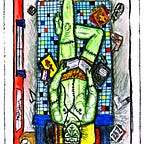Phone Use in Class
by Kallen Fons, Graham Wiltz, and Katie Lawson
A group of design students is interested to see how technology affects the life of a college student. Initially, the group observed which type of technology they seemed to get the most distracted and off topic on. Unsurprisingly enough they discovered that student’s cell phone notifications got them the most distracted. They found that a majority of students either had their phone right next to them on their desk or on their person with vibration notifications on, as to not miss a single notification. Often times the students observed that if one student picked up their phone to look at it, a few would follow suit. This domino effect causes students to simultaneous become engaged in something other than class. This can cause serious problems, especially if what the teacher is talking about is important.
Initially, the observing group of design students thought that important notifications were the main reason that many students picked up their phone, but after further investigation, they found that seemingly no notification, an unimportant one, or just being bored was the cause for the engagement with their personal device. The design group then decided they needed to gather more information via reading up further on the subject as well as conducting surveys and creating an affinity diagram from the information they gathered.
According to Oxford Learning, students check their phones an average of 11 times a school day, which adds up. Rhea Kelley from Campus Technology quoted “The Student Pulse Survey from Top Hat, conducted by independent research firm Survata, polled 520 college students about digital devices, textbooks, and learning. In the survey, they found that a large number of students — 75 percent — believe using personal devices in the classroom has improved their ability to learn and retain information.” This being said one could argue that having their personal device helps the learning process, however, 54 percent also use cell phones to text friends and 52 percent use them to browse social media during class.
After gathering more information, the design group decided to create personas to create a better understanding of individual use of technology in the classroom.
Persona’s
John is a 20-Year-Old sophomore business student that loves music and hanging with friends. He spends quite a bit of time on his phone listening to music and playing games. He sees an increase in cell phone usage during classes. Whenever a friend texts him asking what is he doing after class he will respond right away no hesitation. If the Newest Album drops he will stop and listen right there. What if he had a better way to hide the urge of checking his phone in class.
Rebecca is a 33-year-old Accountant who works at her desk all day. She is a very productive worker. She keeps her phone on her desk in case her kids have an emergency at school, but this gets her distracted sometimes because she is addicted to Candy Crush. What if there was a way she could stay alert to emergencies but not Candy Crush.
Lily is a 17-year-old High school student who has recently gotten the new iPhone 10. Since she has gotten the phone her friends and parents have noticed a change in personality. Lily is always on her phone when friends are hanging out, and at Thanksgiving, Lily seems more interested in taking photos of the food then eating it. What if there was a way she could have restricted access to her phone and get back to her normal self.
A teacher of 6th-12th-grade students the design group interviewed even said “If it’s (technology) is used to reinforce something you’re doing (it can be successful), but learning via technology is very passive learning isn’t always great for something on your own. Maybe not useful to learn something but rather reinforce something already learned”. This idea really sent the design team in the right direction, figuring out where technology is helpful and where it is a hindrance on the learning of the student. After brainstorming ideas of what the team could do to help limit distractions they decided to start prototyping a simple paper prototype of a phone sleeve you can place on the side of your desk or on the back of your laptop.
Quick Prototypes
After showing the prototypes to a few students they said the best versions were the ones with most versatility and seem the most secure. The team them furthered their design for their final solution.
Final
Links: https://www.oxfordlearning.com/should-cell-phones-be-allowed-classrooms/
https://www.newswise.com/articles/94-of-high-school-students-used-phones-during-class
